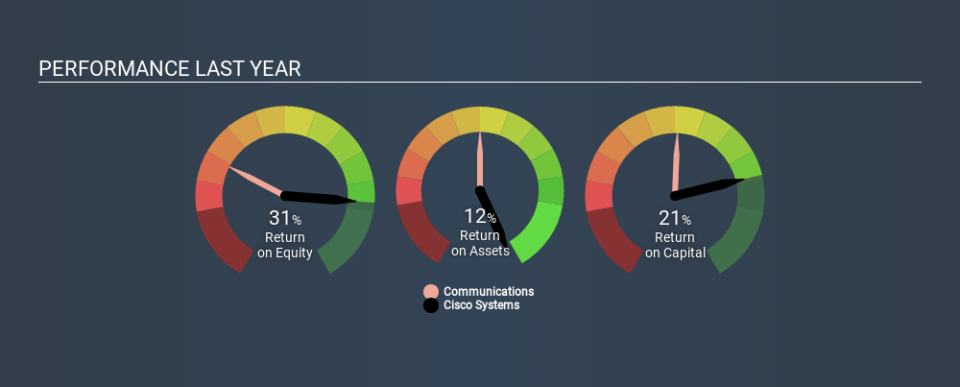Should You Like Cisco Systems, Inc.’s (NASDAQ:CSCO) High Return On Capital Employed?

Today we'll look at Cisco Systems, Inc. (NASDAQ:CSCO) and reflect on its potential as an investment. To be precise, we'll consider its Return On Capital Employed (ROCE), as that will inform our view of the quality of the business.
Firstly, we'll go over how we calculate ROCE. Next, we'll compare it to others in its industry. Last but not least, we'll look at what impact its current liabilities have on its ROCE.
Return On Capital Employed (ROCE): What is it?
ROCE is a measure of a company's yearly pre-tax profit (its return), relative to the capital employed in the business. In general, businesses with a higher ROCE are usually better quality. Ultimately, it is a useful but imperfect metric. Renowned investment researcher Michael Mauboussin has suggested that a high ROCE can indicate that 'one dollar invested in the company generates value of more than one dollar'.
So, How Do We Calculate ROCE?
The formula for calculating the return on capital employed is:
Return on Capital Employed = Earnings Before Interest and Tax (EBIT) ÷ (Total Assets - Current Liabilities)
Or for Cisco Systems:
0.21 = US$14b ÷ (US$90b - US$22b) (Based on the trailing twelve months to January 2020.)
So, Cisco Systems has an ROCE of 21%.
View our latest analysis for Cisco Systems
Does Cisco Systems Have A Good ROCE?
ROCE is commonly used for comparing the performance of similar businesses. Using our data, we find that Cisco Systems's ROCE is meaningfully better than the 5.9% average in the Communications industry. We would consider this a positive, as it suggests it is using capital more effectively than other similar companies. Setting aside the comparison to its industry for a moment, Cisco Systems's ROCE in absolute terms currently looks quite high.
We can see that, Cisco Systems currently has an ROCE of 21% compared to its ROCE 3 years ago, which was 12%. This makes us think the business might be improving. You can click on the image below to see (in greater detail) how Cisco Systems's past growth compares to other companies.
When considering ROCE, bear in mind that it reflects the past and does not necessarily predict the future. ROCE can be misleading for companies in cyclical industries, with returns looking impressive during the boom times, but very weak during the busts. This is because ROCE only looks at one year, instead of considering returns across a whole cycle. What happens in the future is pretty important for investors, so we have prepared a free report on analyst forecasts for Cisco Systems.
Do Cisco Systems's Current Liabilities Skew Its ROCE?
Current liabilities are short term bills and invoices that need to be paid in 12 months or less. Due to the way ROCE is calculated, a high level of current liabilities makes a company look as though it has less capital employed, and thus can (sometimes unfairly) boost the ROCE. To check the impact of this, we calculate if a company has high current liabilities relative to its total assets.
Cisco Systems has total assets of US$90b and current liabilities of US$22b. Therefore its current liabilities are equivalent to approximately 24% of its total assets. A minimal amount of current liabilities limits the impact on ROCE.
What We Can Learn From Cisco Systems's ROCE
, Cisco Systems shapes up well under this analysis, but it is far from the only business delivering excellent numbers . You might also want to check this free collection of companies delivering excellent earnings growth.
For those who like to find winning investments this free list of growing companies with recent insider purchasing, could be just the ticket.
If you spot an error that warrants correction, please contact the editor at editorial-team@simplywallst.com. This article by Simply Wall St is general in nature. It does not constitute a recommendation to buy or sell any stock, and does not take account of your objectives, or your financial situation. Simply Wall St has no position in the stocks mentioned.
We aim to bring you long-term focused research analysis driven by fundamental data. Note that our analysis may not factor in the latest price-sensitive company announcements or qualitative material. Thank you for reading.

 Yahoo News
Yahoo News 

